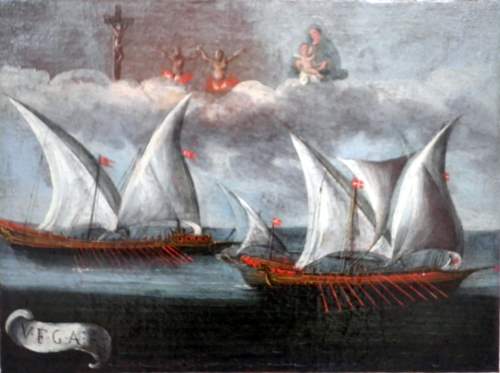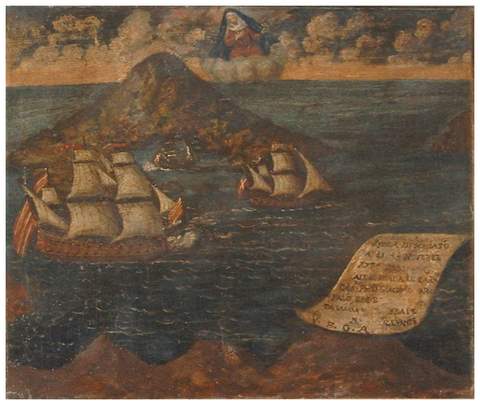| God's Pirates:
The Knights of Malta at Sea
By Mike Bennighof, Ph.D.
October 2015
The Turkish Great Siege of Malta of 1565 ended in a smashing victory for the Knights and their Spanish saviors. The island had been devastated by the fighting, and rebuilding the shattered fortresses would be a tremendously expensive undertaking. The Knights also commenced construction of their new capital city, Valletta, on the Xiberras Peninsula between two fine natural harbors.
Just as the Order needed more cash, many of their best sources dried up. The rise of Protestant faiths in northern Europe deprived the Catholic Order of a substantial amount of property, with its English holdings seized as early as 1540. In response, Grand Master Jean de la Valette and his council decided to expand their piracy from strictly Muslim targets to Christians as well, Venetians in particular.

A Turkish galley attacks while Jesus and Mary look on.
Many Knights resented Venice’s lack of assistance during the Great Siege and remained furious that Venetians had celebrated the fall of Fort St. Elmo. They also rightly suspected the Republic of back-door dealings with the Turks. Papal decrees expressly forbade Christian piracy against other Christians; the Knights ignored the restriction and happily set about plundering Venetian shipping.
During most campaign seasons, the Knights put six or seven galleys to sea. Usually they operated as a single squadron, with their area of operation agreed by the Grand Master and council. Known as the “corso,” the usually annual expedition had the official purposes of protecting Christian shipping and freeing Christian slaves. This included seizing Turkish ships, a definition the Knights extended to cover any ship sailing under the Turkish flag including those owned and crewed by Greek Christians. Since wily Greeks would claim to be subjects of Venice from Crete or the Morea, the Knights took their ships, too.
While the Venetians derided the Knights as “corsairs parading crosses,” the Order and the Republic did come together whenever the Pope managed to forge a Holy League to fight the Turks, most notably at Lepanto in 1571. And, Venice being Venice, soon Venetian traders had found ways to profit from the Knights’ piracy. The Order’s galleys brought thousands of prisoners back to Malta, with the rich and famous held for ransom while the poor and obscure went to the benches of those same galleys or were sold off as slaves. Venetian traders, usually Greeks from the Ionian Islands, obtained safe-conduct passes from the Order and engaged in a brisk trade in ransomed prisoners, both Christians and Muslims. Venetian traders also proved solid customers in Malta’s huge slave market, buying workers for the vineyards of Crete and trading Muslim slaves around the Mediterranean. French slave traders greatly outnumbered the Venetians, and also gladly disposed of the booty taken from captured ships.
While Venice made the best it could of the situation, the Venetians continued to resent the Knights’ depredations and mounted a public relations offensive against the Order – a very effective tool in an age with little understanding of the public sphere. Donations to the Order fell off across Europe, as the Republic’s mouthpieces effectively painted the Knights as despoilers of Christian women.

A big Algerine frigate threatens a Knightly warship, but the Virgin is watching.
Seventy years of truce between Venice and the Ottoman Turks ended thanks to the Order’s holy depredations. In September 1644 the Knights’ galley squadron, with six vessels, encountered a Turkish convoy about 70 miles from Rhodes. The Knights cut out the largest of the Turkish ships while the others fled, and a fierce fight raged for seven hours of hand-to-hand boarding actions. When the big galleon finally fell into the Knights’ hands, 82 Knights and Maltese crewmen had died against about 300 Turks. Among the prisoners was one of the Sultan’s wives and her young son.
The Knights took the battered galleon as a prize, but it suffered in heavy weather and sought to make port on the Venetian-ruled island of Crete. The Venetian authorities, aware that their peace treaty with the Turks required strict neutrality, refused the Knights entrance to any of their ports but the galleys and their prize put in at several undefended coves on the island’s south coast for temporary repairs – useless as it turned out, for the galleon was wrecked on the Italian coast and never made it to Malta.
Using this violation of neutrality as pretext, the Turks launched a massive invasion of Crete that quickly overran all of the island except the capital of Candia, which held out under siege for 21 years. During the siege, Venetian fleets (and those of their European allies, mostly the French) waged fierce naval battles to force through supplies and to take the war to the Turks, with several attempts to force the Dardanelles strait and reach Constantinople. Having started the war, the Knights proved eager to fight it, readily putting their squadron in the service of the Venetians despite the earlier hard feelings. Candia eventually fell, but when Venice went to war with the Turks again in 1684 and in 1714, the Knights and their galleys were in the thick of the fighting.
The Order made a brief and bizarre foray into colonialism in the mid-1600’s, when Cardinal Richelieu named a French knight, Philippe de Longvilliers de Poincy, one of the Knights, as lieutenant governor of France’s Caribbean island possessions. Poincy soon renounced his allegiance to Louis XIII and declared four islands (St. Croix, St. Kitts, St. Bartholomew and St. Martin) under the sovereignty of the Knights of Malta. De Poincy sent his would-be French replacement home in chains, and eventually the Order’s Grand Master, Giovanni Paolo Lascaris, negotiated a truce between De Poincy and his nominal sovereign in 1651 that included the Order paying the French crown-chartered Company of the American Islands for the four islands.
De Poincy assumed the governorship on the Order’s purchase, but when Lascaris sent out a new governor he once again refused to step aside. The Knights made no efforts to assert their authority in the newly-bought islands, and when De Poincy died in 1660 they began efforts to sell them, finally unloading them on the newly-formed French West Indies Company in 1665.
Unable to turn a profit through colonialism, the Knights returned to what they knew best: piracy. During the Golden Age of Piracy in the late 1600's and early 1700's, they continued their “caravans,” long piratical voyages around the Mediterranean, as well as shorter-ranged day trips to attack passing ships. Lax discipline sapped the effectiveness of the Knights’ ships, while the switch to purpose-built warships (and their deployment in trade protection by fleets great and small) left the Order more and more often outgunned. When the Order embarked on Venice’s last war with the Turks in 1714, its squadron commander proved mostly interested in prizes, where his predecessors had constantly urged battle, but did accept Venetian orders when sent against Turkish warships.

The Virgin watches over all eight of the Order's galleys.
By the end of the 18th century, most Knights who sought naval action did so in one of the navies of Europe, usually that of France. The Knights continued to maintain a small fleet of their own, but unlike the Venetians the change in naval technology from oar-powered galleys to big warships powered exclusively by sail left them outmatched by the navies of northern Europe and the Ottoman Empire. The Knights purchased a small number of modern warships from European shipyards, but found it very difficult to assemble full, trained crews for them - galleys continued in use as Muslim slaves for their oars continued to be plentiful.
In 1784, the Order’s sanitary authorities burned a Tunisian-chartered Venetian ship for fear it carried plague. Outraged, the Bey of Tunis demanded compensation and when such was not forthcoming, declared war on Venice. The Venetians dispatched a squadron to Malta built around a ship of the line and a heavy frigate, but even though the Knights possessed heavy warships of their own they apparently could not man them. The Venetians and the last Admiral of Venice, Angelo Emo, conducted the war’s operations on their own without the aid of the Order’s warships (though they made extensive use of their dockyard facilities).
By the time Napoleon and the French arrived, the Order’s days as a military force were done. A small squadron of heavy ships and galleys lay rotting in the Grand Harbour, but the Knights put up no meaningful resistance to the new world order.
In our Serene Empire variant, the Knights receive a small fleet closely allied to Venice as befits their wartime actions. Like the Variant Venetians they’re assumed to have paid slightly more attention to their armed forces and to be ready to play a military role on the seas of the Seven Years War. It’s a fun little variant, and greatly changes the dynamics of the usual Soldier Kings game
Mike Bennighof is president of Avalanche Press and holds a doctorate in history from Emory University. A Fulbright Scholar and award-winning journalist, he has published over 100 books, games and articles on historical subjects.
He lives in Birmingham, Alabama with his wife, three children and his dog, Leopold.
|
